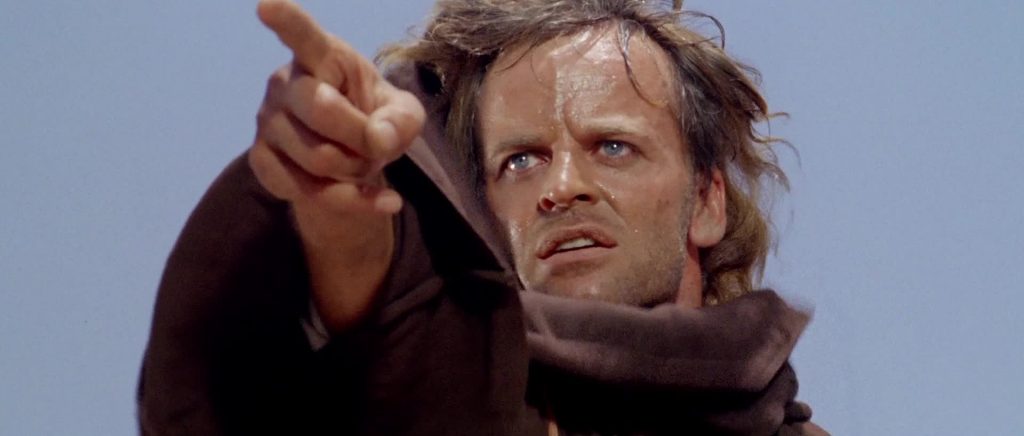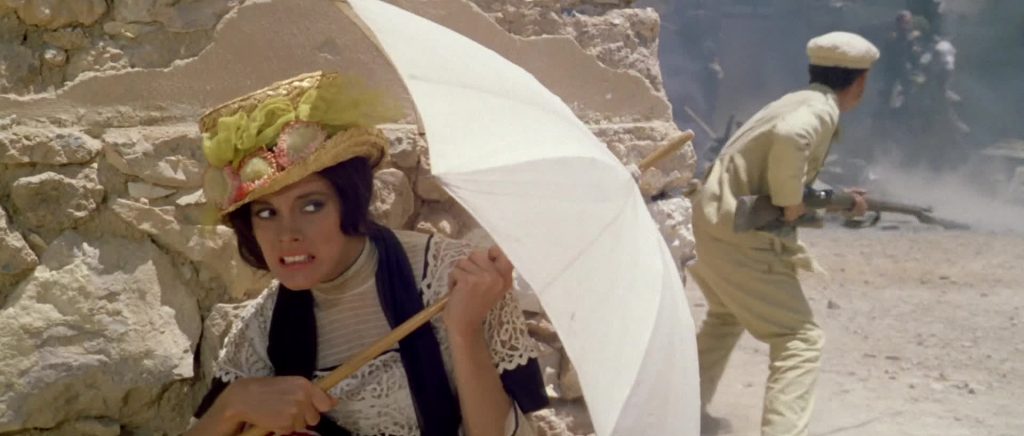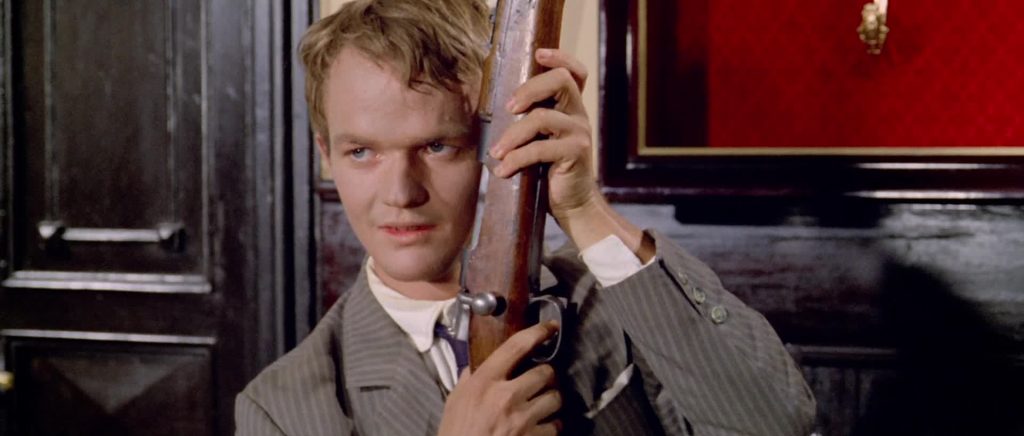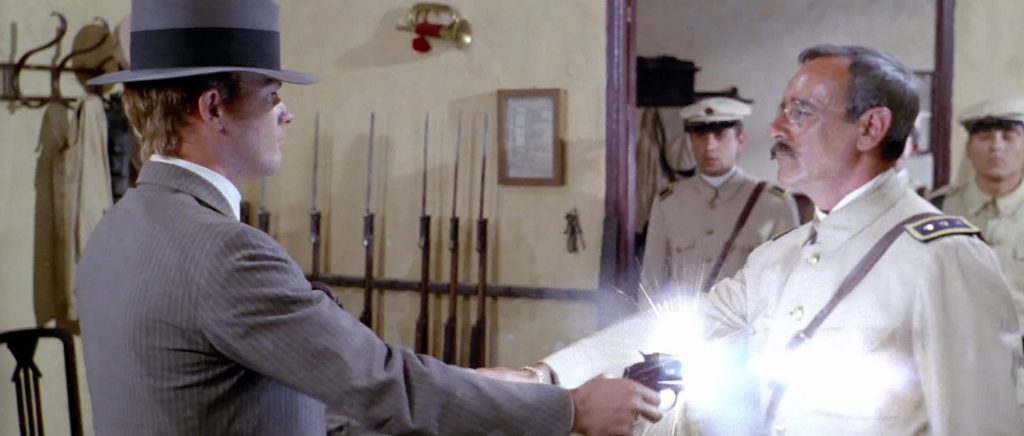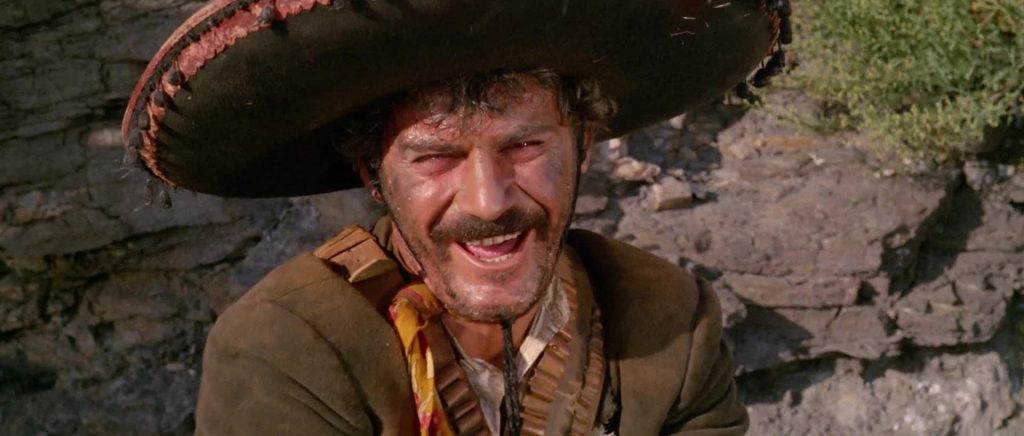[Editor’s note: This essay by filmmaker Alex Cox is excerpted with permission from 10,000 Ways to Die: A Director’s Take on the Spaghetti Western (Kamera Books: 2009) and reframed for Keyframe readers for the Fandor release of A Bullet for the General.]
The Story
During the Mexican Revolution, a government munitions train is forced to stop by the presence of a crucified army officer on the tracks. El Chuncho, a bandit loyal to the Juaristas suffers heavy casualties in his assault on the train—which stops only after Bill Tate, a gringo, murders the engineer. Tate pretends to be a prisoner and joins Chuncho and his small band of revolutionaries after they execute the surviving soldiers. Tate, whom Chuncho christens “Niño,” soon becomes a useful member of the gang, helping them acquire more army weapons, to be sold to Chuncho’s hero, General Elias….
The Film
This is the first Spaghetti Western with a voiceover narration! And, luckily, one of the only ones. It’s at the beginning of the film. We see, as a crowd protests, four citizens shot by firing squad. About to die, one of them calls out, “¡Que viva Mexico!” Cut to a close-up of Bill Tate, the gringo, in his business suit and grey fedora hat, and The Voice is heard:
NARRATOR: From 1910 to 1920, Mexico was torn by internal strife. During the entire decade, the vast territory was devastated by bands of marauding bandits. Scenes of this kind were commonplace, as the various factions tried to dominate the others, and bring order out of chaos.
What gobbledy-gook is this? Who on earth thought it necessary to tell us such a thing? What we’ve just seen is as good a set-up as any; the ensuing film will illustrate all this info as a matter of course. Such a stupid, sententious voiceover—present in both English and Italian versions—suggests a bad film. But what follows is excellent. ¿Quien Sabe? [A Bullet for the General] is so good, it seems like an authentic document of the Mexican Revolution, a long war in which both sides acted with extreme cruelty to the enemy and callous disregard for their own people’s suffering.
The art director, Sergio Canevari, had worked on [The] Battle of Algiers. He brought a rigorous attention to detail—from small items like paper amulets and straw-mat coffins, to Nacionales de Mexico rolling stock, and huge, fake organ-pipe cacti, planted in the Almería desert. The result of Canevari’s work, together with Marilu Carteny’s costumes and the mobile camera of Tony Secchi, is a Spaghetti Western which seems 100 percent authentic. Nothing is out of place in ¿Quien Sabe?, a fully realized political allegory about U.S. involvement in Latin American politics which is simultaneously an entertaining action film, and a painful meditation on heroes, and their heroics.
Gian Maria Volonte and Lou Castel (this supergringo was, in fact, a Colombian named Luigi Castellato) are both excellent. The one element which might seem out of place is Klaus Kinski’s character: a blond, blue-eyed, brown-robed priest who is allegedly Chuncho’s half-brother. But all the scenes involving El Santo are fine: Kinski was still giving his best efforts to the roles he played, and his scenes with Gian Maria Volonte are the best in the film. Both actors were famously intense, so Damiano Damiani, the director, had his work cut out for him. Volonte’s wife, the striking, red-headed Carla Gravina, had been hired to play an aristocratic enemy of the Revolution (and, one imagines, to keep Volonte occupied). Still, on one occasion the director came to blows with his actor, knocking him off his horse. Volonte, disliking his costume, had turned up naked on set. Yet their work was excellent, and I imagine Damiani was grateful for the constant presence of Solinas, his celebrated script-rewriter. Solinas could engage with Volonte and Castel about their roles, or their shared leftist politics, he could talk to Kinski about women, he could chat to his friends in the art department about the authentic details of the set. Such a writer can be of great benefit to the director, freeing him/her up for other directorial things.
Given the terrible cruelty of the Mexican Revolutionary War, it’s not surprising that the most striking moments of ¿Quien Sabe? are violent ones: the officer crucified on the railroad tracks; the rebels’ execution of the Rurales; the shooting of the wounded. So it was a problem when these moments—important for the film—were all cut for the film’s U.K. release: a massive lurch from 135 to 77 minutes, leaving behind an unintelligible film, retitled A Bullet for the General. Longer versions exist (in France, the film was called El Chuncho) but the complete one seems to be lost. But what remains of ¿Quien Sabe?—the 102-minute version, say—is excellent. [Editor’s note: The version of this film available on Fandor is 118 minutes, and the author writes that “It’s the best-looking version of the film I’ve seen, and also the longest. And I love the mixture of Italian, Spanish and English dialogue!”]
¿Quien Sabe? seems to have influenced The Wild Bunch, Peckinpah’s masterpiece, shot the following year. Both films share the same sympathy for the followers of Juarez versus the murderous crew who control the army (Solinas and Damiani are less idealistic overall than Peckinpah, as we shall see). Both feature a bandit leader with an entourage of young peasant boys: the style is the same, as are the costumes. The caudillo—the big guy—is the same, whether it’s our hero, Chuncho, or Peckinpah’s villain, Mapache. Chuncho and Mapache are childishly obsessed with technology: automobiles and machine guns. Both directors focus on the presence of children. And both cast the same actor as an iconic Mexican character: Jaime Fernandez, who played the Revolutionary general, Elias, in ¿Quien Sabe?, and the Revolutionary kid, Angel, in The Wild Bunch. Peckinpah usually pretended ignorance of foreign films, or any influences upon his work. But I find it impossible to believe Sam didn’t see ¿Quien Sabe?.
These Italians had a more complex view of the Revolution than Peckinpah and his screenwriters. All saw it in allegorical terms: for Peckinpah, it was an allegory of Vietnam, for Solinas, of U.S. interventions in Latin America. But Peckinpah, in his depiction of the Juarista rebels and their village life, is entirely positive: the scenes in Angel’s village are among the only entirely optimistic moments in his usually dark oeuvre. Solinas and Damiani take a more jaundiced view. After the liberation of San Miguel, Secchi shoots a two-minute plano secuencia in which we’re introduced to Chuncho’s old friend Raimundo, now lacking an arm, and learn that it’s time to deal with the local aristocrat, Don Felipe. Chuncho is in favor of killing him, but, after dallying with the Don’s wife, Rosario (Gravina), Chuncho shoots one of his own men, and conscripts Don Felipe as his chauffeur. The film forgets him for a while; then, at the end of a night-time fiesta in the newly liberated village, the camera cranes down to reveal Don Felipe’s corpse, lying in the street. How, the film asks, can a Revolution so cruel to its enemies, and so careless of its own, survive? This is a good question, which later ‘Tortilla Westerns’ (as these Revolution-themed pictures became known) sometimes forgot to ask.
Chuncho kills his henchman, Guapo, because Guapo has threatened the gringo, Tate. Chuncho has fallen in love with the mysterious gringo, whom he has named “Niño.”
EUFEMIO: Chuncho! Why’d you kill Guapo?
CHUNCHO: Because Guapo… was about to kill Niño. And Niño… is a friend of mine.
PICARO: Wasn’t Guapo a friend of yours, too?
CHUNCHO: He’s no more. Don’t worry about him.
Guapo means “beautiful,” and niño in Spanish means “little boy.” It’s the same nickname Volonte’s character gave to his enormous henchman in For a Few Dollars More. Chuncho’s infatuation with Tate, and Tate’s desire to reform and tame the savage Chuncho, give us the first overtly gay bond, I think, in any Western. Certainly there were implicit male affairs in many Westerns, American and Italian, before this one. But this is the first time the love affair was clearly on the table. Not that it’s portrayed as a good thing: Chuncho’s love for Tate causes a catastrophe for the Juaristas; Tate’s obsession with Chuncho brings about his death. For all that, ¿Quien Sabe? is still a love story.
I once thought ¿Quien Sabe? to be critical of General Elias, the well-dressed Juarista leader who Bill Tate kills. Elias is, indeed, attired like an aristocratic gentleman; he’s clean-shaven, unlike most of the revolutionaries. But he is playing a part: the caudillo’s caudillo, the leader of a Revolutionary Division, like Villa, or Zapata. When we first see him, in his headquarters, he offers the hand of friendship to a gringo, or a well-dressed guy, whose support he clearly needs. Elias is a politician, and revolutions need politicians. His endorsement of Chuncho’s self-judgement, as a traitor who must be executed, is entirely sound. Tate’s assassination of Elias is a disaster, which will only prolong the war and raise the body count. It is an outrage; yet it recalls the murder of Don Felipe, an ineffectual aristocrat, who, stripped of his power, threatened no one. Solinas and Damiani provide no answers. Everyone in the film is trapped in an impossible situation: the lieutenant on the train, unable to give the order to proceed and crush his captain, crucified on the tracks; Don Felipe and Rosario, awaiting their death sentence; Santo and the army priest, who condemn each other, and die on the battlefield; Adelita, who loses her lover and abandons the cause; Chuncho and Niño, narcissists destined to destroy each other. ¿Quien Sabe? seems like an immediate riposte to Solinas’s own The Big Gundown. In that film, Corbett and Cuchillo could resolve their differences and coexist, as equals; none of the characters here can do this. Both societies— primeval South, Machiavellian North—are destined to go down in flames.
Such is the pessimistic conclusion of the first, and best, of these Tortilla Westerns. None of the later ones, not even Sergio Leone’s, came near to ¿Quien Sabe? in intelligence, narrative or insight. Its allegory is pertinent and sustained, but never intrudes. The “Good” gringo is morally inferior to the “Ugly” Mexican; in fact, he is not good at all—but neither is the Mexican. And who is the “Bad?” Is it the crucified officer? Is it Don Felipe, quaking with fear? Is it Chuncho’s gang, who care more for money than ideas? Or is it the Mexican generals, in their office with pictures of sailing ships, paying Bill Tate 100,000 pesos to kill their countryman, then asking for a receipt?
Even someone as ignorant of music as I can recognize a great score by Luis Enriquez Bacalov: it’s an excellent orchestral soundtrack, which, at times, entirely recycles some of Bacalov’s original music for Django. Ennio Morricone received a credit as Music Supervisor, but this seems to have been a device of the producer to profit from Morricone’s growing reputation.
Excerpted with permission from 10,000 Ways to Die: A Director’s Take on the Spaghetti Western (Kamera Books: 2009).



